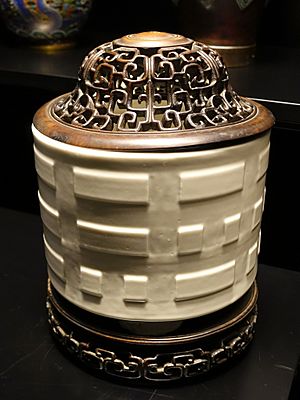I Ching facts for kids
| Author | Fu Xi |
|---|---|
| Original title | 易经 |
| Country | China |
| Language | Chinese |
The I Ching (易经), also known as the Book of Changes, is one of the oldest and most famous Chinese classic texts. For thousands of years, people have used it mainly for divination, which is a way of trying to understand the future or get advice.
Contents
History of the I Ching
The main parts of the I Ching were written during the early Zhou Dynasty (around 1046 BC to 771 BC). Before the Zhou Dynasty, there was the Shang Dynasty (around 1600 BC to 1046 BC). The Shang people were known for their special ways of telling the future and their ancient Chinese writing.
During the Shang Dynasty, people would try to predict the future by burning animal bones or tortoise shells. They would look at the cracks that formed to get answers. When the Zhou Dynasty took over, they kept many of the Shang's cultural ideas.
In the early Zhou period, a new and more advanced way of telling the future appeared. This new method was written down and eventually replaced the older Shang ways. This written method became what we know today as the I Ching.
What's Inside the I Ching?
The I Ching is made up of 64 special symbols called hexagrams. Each hexagram has its own explanation. A hexagram is a group of six lines, stacked one on top of the other.
Understanding Hexagrams
These lines can be either broken or unbroken.
- A broken line (which has a gap in the middle) represents yin.
- An unbroken line represents yang.
The lines are read from the bottom to the top. Each hexagram has a unique name. In the I Ching book, you'll find the name of a hexagram first, then the hexagram itself. After that, there are detailed explanations for the whole hexagram and for each of its six lines, from bottom to top. Once all the explanations for one hexagram are given, the book moves on to the next one.
Tools for I Ching Divination
To use the I Ching for divination, people traditionally used 50 thin sticks, often made from bamboo. By following a specific process with these sticks, a person could create a hexagram. Then, they would look up the meaning of that hexagram in the I Ching book to find their answer or advice.
To make this process easier and faster, some people now use coins instead of sticks to create their hexagrams.
Big Ideas in the I Ching
The I Ching contains some important philosophical ideas about life and the world.
Heaven and Judgment
In the I Ching, the word 'Heaven' (which is '天' in Chinese) is often seen as being like a wise and powerful being, similar to a God. This 'Heaven' is thought to decide what is good or bad and to make judgments. For example, one explanation in the book says, "the Heaven's bliss is given, therefore, lucky." This means good fortune comes from Heaven.
Constant Change
Another key idea in the I Ching is that the world is always changing. Nothing stays the same forever. The explanation for the 11th hexagram says, "Everything flat will be inclined, and everything gone will be come back." This means that things go up and down, and what leaves will eventually return.
Endless Cycles
The I Ching also teaches about the idea of endlessness. The 63rd hexagram is called "Already Finished." But the very last hexagram, the 64th, is called "Not Finished." This shows that life and the world are a continuous process that never truly stops. It's like a cycle that keeps going on and on.
Images for kids
See also
 In Spanish: I Ching para niños
In Spanish: I Ching para niños






